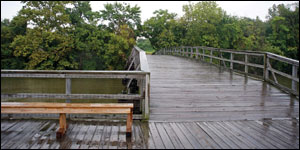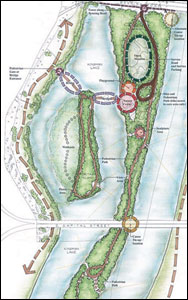|
A New Beginning for Kingman Island

Bridge to the future, a wooden walkway leads visitors to a small network of trails on Kingman Island (above). The area reopened for education and recreation in 2008. When restoration is complete, Kingman Island will host an environmental education center, a playground, and a picnic area. A memorial tree grove will honor the D.C. schoolchildren who fell victim to the September 11th attack (see proposed master plan at right).
Credits: photo Erica Goldman and master plan D.C. Office of Planning. Click on the master plan to see a larger version. |
 |
Construction on Benning Road has brought traffic down to one lane, making chaos of the congested morning commute. But a quick left turn onto Oklahoma Avenue followed by another left into the RFK Stadium parking lot brings a sudden quiet. A lone car at the far end of the parking lot is the only sign of human activity this gray morning.
Light rain slicks the asphalt of the empty parking lot and the Orange Line metro train roars overhead. But behind parking lot 6, black wrought iron gates stand open, welcoming visitors out of gritty Northeast D.C. and into an unspoiled wilderness area.
The car belongs to Matt English. He's just finished opening the access gate to Kingman Island and Heritage Island, which together cover 45 acres in the Anacostia River. A wooden pedestrian bridge leads visitors to a lookout over Kingman Lake, a platform large enough for school groups to assemble for educational programs or to dangle fishing rods into the Anacostia River below.
The bridge and platform overlook the patches of restored marsh of Heritage Island and Kingman Lake that have managed to thrive in spite of hungry geese (see Marsh in the City, p. 5). Stands of wild rice in full flower, planted by the Anacostia Watershed Society, sway in the wind-swept rain. Wild rice was habitat for the famed Sora rails, birds once common in this region and now all but extinct.
English crosses a second bridge over Kingman Lake, pulling up the hood of his jacket as the rain begins to fall harder. He tucks his logbook into his jacket to keep it dry as he heads down the main entrance trail to Kingman Island. Every morning, ever since the island opened to the public in May 2008, English has opened the gates and checked the condition of the trails, making sure that they're clear of debris and free of trash. English is the Kingman Island Coordinator for Living Classrooms, a non-profit that provides environmental programming for school groups and the public. He's in charge of helping the public discover Kingman Island and use it for recreation and exploration.
Kingman Island has a storied background. When it was created in 1916 from sediment dredged from the Anacostia River by the Army Corps of Engineers, its whole 95 acres initially fell under the jurisdiction of the National Park Service. For the first few decades, Kingman Island remained untouched wilderness. In 1939, the National Park Service opened the Langston Golf Course in the northern half of the island. The course was built as a segregated golf facility, named for John Mercer Langston, the dean and founder of Howard University's Law Department and the first black congressman elected from Virginia. It is still a favorite course for African American golfers.
The fate of the southern half of Kingman Island became the subject of decades of wrangling. The 1940s saw plans to build a private airstrip. During World War II people grew "Victory Gardens" there. In the 1970s, there was a proposal for a children's recreation center. In the 1980s, an Indian philanthropist who was also an Italian countess sought to build an amusement park on the island. In 1996, the National Park Service transferred the ownership of the southern half of the island to the District of Columbia, who negotiated a 99-year lease with private developers to construct a $150 million theme park on the island.
Concern over the "environmentally appropriate" nature of such a project and its impact on local real estate values sparked intense community opposition from the neighborhoods of Kingman Park and River Terrace. Under considerable pressure from the D.C. Council member from Ward 6, the District's financial control board ultimately rejected the proposal in 1999.
Amidst the controversy, the island was closed to the public — at least officially. Unofficially, it became a dumping ground for leaves by the city and for bricks, pipes, and tree stumps by others. Homeless people camped out there. Rumors circulated that arson destroyed the old pedestrian access bridge.
|
Through the gate each morning at 9:00 am, Matt English opens up Kingman Island and walks the trails to check for debris. English works for Living Classrooms, a Baltimore-Washington nonprofit educational group that focuses on hands-on learning.
Credit: Erica Goldman. |
The Anacostia Waterfront Revitalization Plan proved the push needed to redirect Kingman Island toward environmental restoration and public access. This effort began 10 years ago when the District executed a Memorandum of Understanding for the Anacostia Waterfront with over 20 District, federal and state agencies. Since then, Kingman Island and Heritage Island have become District-funded restoration projects, led by the D.C. Office of the Deputy Mayor for Planning and Economic Development. Beginning in 2000, groups like the nonprofit Earth Conservation Corps (see Taking Out the Trash, p. 14) have removed trash from the island and built a bridge for visitor access. In parallel, the National Park Service and the Army Corps of Engineers have worked to rebuild the wetlands surrounding the island.
Since the islands reopened in 2008, Living Classrooms has been hosting environmental education programs for school children and leading public tours. The District's restoration plans will eventually include a new Environmental Education Center, designed to achieve the highest level of green building certification, and a memorial tree grove dedicated to D.C.'s schoolchildren who were victims of the September 11 terrorist attack.
The tree canopy provides some shelter from the rain as Matt English turns down a narrower trail leading toward the southern end of Kingman Island. This trail passes under busy East Capitol Street, a covered area sporting some graffiti, that has proved difficult to keep free of trash.
English works to engage the community in volunteer trash cleanups. The D.C. neighborhoods of Rosedale and Kingman Park in particular have shown a lot of interest. Walking the trails each day, he's met people who used to come out to the island in their youth but who haven't been out in years. Slowly he's getting the word out that Kingman Island has once again become a resource for all to enjoy.
At the end of the trail, English takes a pencil out of his pocket and notes some downed branches in his logbook. It's not a high priority area because it's at the far end of the island and few visitors make it to this point. Still it will go on the list of problems to be attended to.
He heads back to the junction of the north and southbound trails. The rain is still coming down so he decides to hold off on walking the northern portion until later in the afternoon. He'll be back on Kingman Island around 4:30 pm to close up the gates for the night and will scope out the northbound trail then. He'll walk all the trails to make sure no one gets left behind.
Cinching his hood against the rain, he makes his way back over the bridge and through the gates, heading for his car parked in the still-empty stadium parking lot.
— Erica Goldman
|